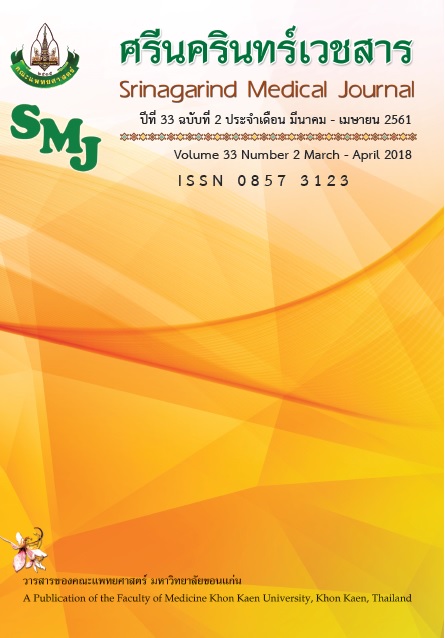Severity of Adverse Drug Reactions by Patient Self-Reporting
คำสำคัญ:
Patient self-reporting; severity; adverse drug reactions; การรายงานอาการไม่พึงประสงค์โดยผู้ป่วย; ความรุนแรง; อาการไม่พึงประสงค์จากยาบทคัดย่อ
Background and objective: Patient self-reporting of adverse drug reactions (ADRs) is an alternative method to increase reporting rate of ADRs, however, there have been limited studies regarding severity of experience ADRs in patient perspective particularly ambulatory patients in university hospitals. Therefore, this study aimed to explore severity of ADRs experienced by patients in relation to frequency, type of ADRs and suspected drugs. In addition, factors associated with the self-reported ADR severity were evaluated.
Method: This was a cross-sectional study. Self-administered questionnaires were distributed to patients by purposive sampling. Experience ADRs occurring in last one year previously were identified by participants at out-patients clinics, Srinagarind hospital during 1 July 2016 – 28 February 2017. ADR severity was rated by patients using Visual Analogue Scale (VAS) and divided into three levels as mild, moderate, and severe. Data were analyzed by descriptive statistics, Chi-square test and multivariate analysis.
Result: There were 390 valid questionnaires with a response rate of 78.0%. A total of 1,152 symptoms related to ADRs were reported by patients. Mean VAS severity was 4.5 ± 3.45. The common severity of experience ADRs were reported as mild (46.7%) and severity (22.4%). The most frequent suspected drug included amoxicillin (6.1%), peg-interferon (6.1%), and valproic acid (6.1%). Multivariate analysis showed that patients aged 30-50 years, receiving concomitant drugs, level of anxiousness about the ADR and its disturbance on daily life were the independent factors associated with the ADR severity. (p=0.007, p=0.047, p <0.001, p<0.001, respectively).
Conclusion: Patients were likely to report ADRs which were common and easily noticed by themselves. Patients with older age, concomitant drug prescribed, and greater concern about the ADRs affecting to daily life tended to report more severe ADRs. Therefore, health care professional should pay more attention to aid patients in ADR self-reporting and self-identification in order to increase patients’ drug safety and confidence in medication use as well as improve reporting rate of ADRs.
ความรุนแรงของการเกิดอาการไม่พึงประสงค์จากยาโดยการรายงานของผู้ป่วย
ศิริญญา คำพิชิต1, ธงชัย ประฎิภาณวัตร2, นฤมล เจริญศิริพรกุล1*
1 สาขาเภสัชกรรมคลินิก คณะเภสัชศาสตร์ มหาวิทยาลัยขอนแก่น
2 ภาควิชาอายุรศาสตร์, คณะแพทยศาสตร์ มหาวิทยาลัยขอนแก่น
หลักการและวัตถุประสงค์ : อาการไม่พึงประสงค์จากยา (adverse drug reactions; ADRs) โดยผู้ป่วยรายงานโดยตรง (patient self-reporting) สามารถเพิ่มอัตราการรายงาน ADRs อย่างไรก็ตาม ยังมีการศึกษาจำกัดถึงความรุนแรงและปัจจัยที่มีผลกระทบต่อความรุนแรงของการเกิด ADRs ในมุมมองจากประสบการณ์ของผู้ป่วยโดยเฉพาะผู้ป่วยนอกในโรงเรียนแพทย์ การศึกษานี้จึงมีวัตถุประสงค์เพื่อศึกษาถึงความรุนแรงในการเกิด ADRs โดยจำแนกตามความถี่และชนิดของยาที่เป็นสาเหตุและปัจจัยที่มีผลต่อความรุนแรงต่อการเกิด ADRs โดยผู้ป่วยรายงานโดยตรง
วิธีการศึกษา : เป็นการศึกษาเชิงพรรณนาแบบภาคตัดขวางโดยทำการศึกษาในการค้นหา ADRs ที่เกิดขึ้นจากยา ย้อนหลัง 1 ปี เก็บข้อมูลโดยใช้แบบสอบถามประเภทตอบด้วยตนเองโดยสุ่มเลือกผู้ป่วยแบบเฉพาะเจาะจง ณ ผู้ป่วยนอก โรงพยาบาลศรีนครินทร์ คณะแพทยศาสตร์ มหาวิทยาลัยขอนแก่น ระหว่างวันที่ 1 กรกฎาคม 2559 ถึง 28 กุมภาพันธ์ 2560 ประเมินความรุนแรงด้วย Visual Analogue Scale (VAS) และแบ่งความรุนแรงออกเป็น 3 ระดับคือ สูง (VAS 7.1-10.0) ปานกลาง (VAS 4.1-7.0) และต่ำ (VAS 0.0-4.0) วิเคราะห์หาความสัมพันธ์ระหว่างตัวแปรโดยใช้ Chi-Square test และ Multivariate analysis
ผลการศึกษา : ผู้ป่วยตอบแบบสอบถามที่สมบูรณ์และนำมาวิเคราะห์ได้ 390 ฉบับ (ร้อยละ 78.0) รายงานอาการผิดปกติอย่างน้อย 1 อาการรวมทั้งสิ้น 1,152 อาการ คะแนนความรุนแรง VAS เฉลี่ยเท่ากับ 4.5 ± 3.45 โดยผู้ป่วยส่วนใหญ่มีความรุนแรงระดับต่ำ (ร้อยละ 46.7) และระดับสูง (ร้อยละ 22.4) โดยยาที่ผู้ป่วยรายงานความรุนแรงระดับสูงบ่อยที่สุด คือ amoxicillin (ร้อยละ 6.1) peg-interferon (ร้อยละ 6.1) valproic acid (ร้อยละ 6.1) ปัจจัยที่มีผลต่อความรุนแรงของ ADRs อย่างมีนัยสำคัญทางสถิติ ได้แก่ ช่วงอายุ 30-50 ปี (p=0.007) ได้รับยาอื่นร่วม (p=0.047) ระดับความกังวล (p <0.001) และการรบกวนต่อการดำเนินชีวิตประจำวัน (p<0.001)
สรุป : ADRs ที่ผู้ป่วยรายงานมีระดับความรุนแรงต่ำถึงปานกลาง สามารถสังเกตได้ง่าย โดยความรุนแรงของADRs ที่รายงานมีความสัมพันธ์กับอายุที่มากขึ้น การได้รับยาอื่นร่วม ระดับความกังวลและการรบกวนการดำเนินชีวิตประจำวันที่เพิ่มมากขึ้น ดังนั้นบุคลากรทางการแพทย์ควรให้ความสำคัญกับการรายงานของผู้ป่วยและช่วยระบุค้นหาว่าอาการดังกล่าวเป็นผลจากยาจริง เพื่อเพิ่มความปลอดภัยและความมั่นใจในการใช้ยาแก่ผู้ป่วยและเพิ่มอัตราการรายงาน ADRs จากยา




